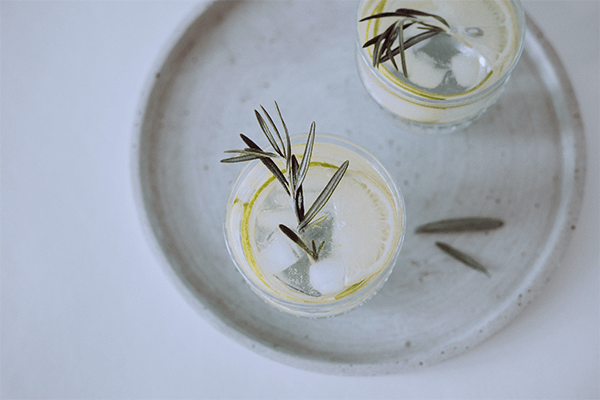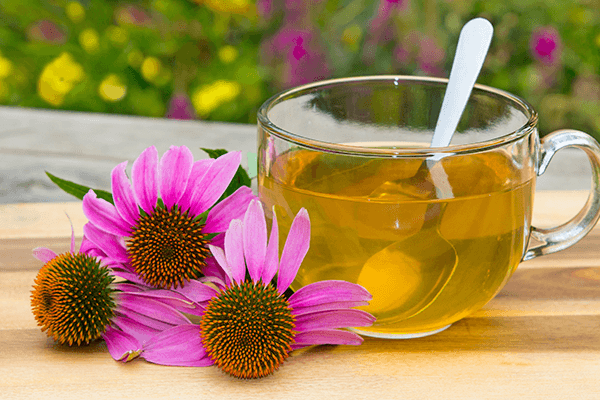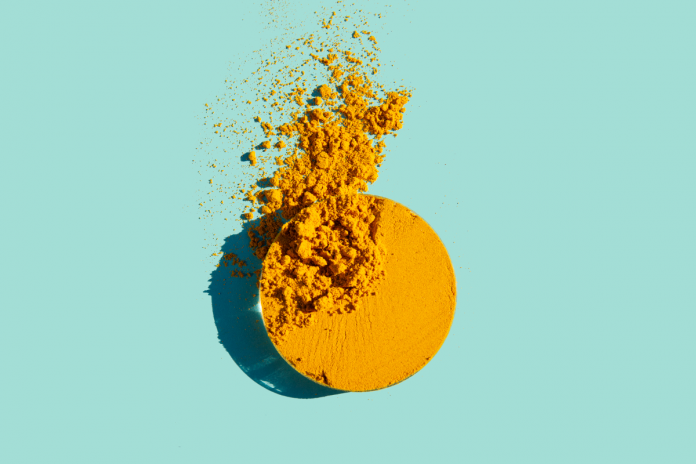Mint tea is a fresh, aromatic beverage that’s delicious and refreshing, whether served hot or cold. We love it because it’s caffeine-free, yet stimulating, with a pleasant combination of relaxing and invigorating properties.
Have you ever wondered whether mint tea has health benefits?
We’re digging into the research below, as well as the background of mint tea, the differences between peppermint and spearmint teas, and how to make your own delicious, soothing mint tea at home.
What is Mint Tea?
Mint tea is what you might expect: any herbal tea made from mint. Herbal teas are also sometimes called tisanes or infusions.
Unlike true teas that come from the Camellia sinensis plant, herbal teas (like mint tea) don’t contain any caffeine. And today, we’ll only be looking at pure mint teas–not flavored teas like mint green tea.
No one knows for sure the origin of mint tea, but chances are high that it goes as far back as humans’ ability to boil water!
Where does mint come from?
The mint family, officially called Mentha, belongs to the Lamiaceae family of plants. The Mentha family of herbs contains up to 24 different species, of which spearmint and peppermint are the most popular.
Spearmint (Mentha spicata) is a green, leafy herb that originated in Europe and Southern Asia, but is now naturalized in temperate climates around the world. This herb gets its name from its pointed or “spear-like” leaves.
You’ve probably experienced spearmint in Greek and Middle Eastern cuisine, as well as a common scent or flavor in products like shaving creams, toothpaste, and chewing gum.
Peppermint, on the other hand, (Mentha × Piperita) is a hybrid of spearmint and watermint. Peppermint gets its name due to its high menthol content, which lends it a spicy or “pepper-like” flavor.
Peppermint originally grew in Europe and the Middle East, but, like spearmint, has since spread throughout the world.
You’ve likely tasted peppermint in candies like candy canes, as well as plenty of sweet baked goods. Unlike its subtler sibling spearmint, bold peppermint is usually the star of any recipe in which it’s featured.
Along with their unique, refreshing flavors and aromas, mint teas and other mint-derived infusions offer several valuable potential health benefits. Keep reading to find out what they are!
6 Benefits of Drinking Mint Tea
1. Supports Memory, Alertness, and Concentration
According to some studies, both spearmint and peppermint may support healthy brain function and cognition.
Most remarkably, a study of older adults given spearmint extract showed a large increase in working memory (1). A mouse study also showed that mice given a spearmint extract performed better in a maze test, indicating better memory (2).
And in a 2018 randomized controlled trial published in the journal Nutrients, 24 young, healthy subjects performed better on cognitive tests and experienced less fatigue after taking peppermint oil capsules compared to placebo (3).
Interestingly, the aroma of mint may be beneficial all by itself. For example, a study of 144 subjects found that smelling the scent of peppermint essential oils supported alertness and memory (4).
We should point out that researchers in these studies tend to use mint essential oils or other extracts instead of mint tea. And while there’s less scientific evidence regarding mint tea, it’s possible that some of the benefits still translate.
2. Supports Healthy Digestion
Did your mom ever give you mint tea to help settle your stomach?
This is perhaps the earliest-known traditional therapeutic use of mint. You can go back centuries and find documented uses of mint for digestive support in the traditions of Ayurvedic medicine, Traditional Chinese Medicine, ancient Greece (spearmint originated in the Mediterranean) and early Britain (once the herb was introduced there).
In the modern era, human and animal studies alike suggest that spearmint and peppermint may both support healthy digestion as well as support digestive comfort (5)(6)(7)(8)(9)(10)(11)(12)(13).
How? According to one animal study, peppermint has the ability to support the relaxation of smooth muscle (14). In other words, mint tea may work to ease unpleasant stomach sensations and “move things along.”
3. Supports Fresh-Smelling Breath
Spearmint and peppermint are common flavorings in toothpaste, mouthwash, and gum. One obvious reason is because the sweet yet powerful scent of mint can immediately freshen up your breath.
But researchers also think spearmint and peppermint support fresh breath because of their antibacterial properties (15)(16).
In one study, young women who used a mouth rinse containing peppermint for one week had fresher breath compared to women in the control group (17).
4. May Support Healthy Immune Function
Peppermint contains a compound called rosmarinic acid, which is found in herbs like rosemary and various other mint species (18).
Human and animal studies suggest that rosmarinic acid in peppermint tea may support healthy immune function as well as support the body’s natural anti-inflammatory response (19)(20)(21)(22).
5. Full of Antioxidants
Plant antioxidants are natural compounds that plants make to protect themselves and repair damage. And for humans, eating plant-based antioxidants supports cell signaling, cell survival, and a healthy metabolism (23).
Spearmint is high in natural antioxidants including rosmarinic acid, flavones, flavanones including limonene and menthol, and vitamin C (ascorbic acid) (24)(25).
And peppermint contains menthol, menthone, rosmarinic acid, caffeic acid, flavones, flavanones, terpenes, and vitamin C (26)(27).
6. May Support Hormonal Balance
Spearmint and peppermint tea may help support natural, healthy hormone levels for women (28)(29)(30).
Peppermint Tea vs. Spearmint Tea: What’s the Difference?
As we just learned, the health benefits of spearmint and peppermint often, but not always, overlap. However, the respective flavors of spearmint and peppermint are very distinct.
Spearmint has a flavor best described as sweet, cool, and subtle. That’s why in culinary settings, spearmint most often accompanies savory dishes (for example, it’s in tzatziki sauce in Greek cuisine).
On the other hand, peppermint’s flavor is tingly, spicy, and bold. And if you add peppermint to a recipe, it’s anything but subtle–think of candy canes or mint bark around holiday time.
The flavors and other differences between spearmint and peppermint are due to the different compounds that occur in each species of mint.
The most abundant compound in spearmint, carvone, gives spearmint its distinctive smell. This terpene is also found in caraway seeds and dill. And along with carvone, limonene and dihydrocarvone also feature prominently in the scent and flavor profile of spearmint.
In contrast, peppermint contains a lot of menthol–up to 40 times more than spearmint. Menthol and the related compounds menthone and menthyl acetate lend peppermint its powerful, punchy character.
But perhaps best of all, neither spearmint nor peppermint tea has any known side effects.
Ultimately, the best way to get acquainted with each type of mint tea is to experiment.
Therefore, whether you’re primarily interested in a refreshing minty taste treat or in supporting your health with herbal tea, you should make a point of trying spearmint tea as well as peppermint tea.
Mint Tea in Traditional Chinese Medicine
According to traditional Chinese medicine (TCM), spearmint (Bo He) and peppermint (See Bo He) have distinct properties.
Perhaps most surprisingly, one is considered to have a “cooling” essence, while the other is “warming.”
Spearmint tea is regarded as gentle, cooling, and helpful for removing heat from the heart and lung centers. It is also considered helpful to reduce “overheated” emotional states such as irritability, anger, or passion.
Conversely, peppermint is warming, with more stimulating effects compared to spearmint. It also has an affinity for the lower digestive tract, making it an excellent digestive aid.
Keep in mind that in TCM, the cooling or warming properties of tea refer to the tea’s essence, and therefore apply regardless of whether you consume that tea hot or cold.
Therefore, you could drink hot spearmint tea to cool down–even on a summer day. And vice versa: according to TCM, a cool glass of peppermint tea would help you warm up any time of year.
How to Make Mint Tea at Home
You can find mint tea in tea bags, as loose-leaf dried herb, or–the best way–high quality fresh herb, preferably home-grown.
Here’s how to make your own spearmint or peppermint tea (total time: 10 minutes):
- Boil 2 cups of water
- Remove the boiling water from heat
- Crush or tear a generous handful of mint leaves, then add them to the hot water
- Cover, then steep 5 minutes
- Strain the tea, then drink
Or, to make iced tea, use 1-1.5 cups of boiling water, then add lots of ice after you finish steeping.
Note that unlike true teas, you won’t get much mileage out of additional infusions. That means you can toss your used leaves into the compost rather than re-steep.
And because mint tea is naturally caffeine-free, you can enjoy it at any time of day or night.
Try it after meals as a tummy soother and breath freshener, for a mid-afternoon boost, or as a pre-bed relaxation ritual.
Also, if you can’t find fresh mint locally, try planting it yourself.
As long as you live in a temperate climate, perennial herbs like mint are incredibly easy to grow. (And if you live far to the north, you may be able to cover your mint plants to help them survive the winter.)
Simply purchase some young spearmint or peppermint plants, then plant them somewhere moist but well-drained.
Both species do best with a mix of sun and shade. Expect them to get 1-2 feet high.
However, be aware that if you have favorable conditions, they may reproduce and spread outward rapidly–mint tea for your whole neighborhood!
Also note that it’s best to plant spearmint and peppermint apart, not as neighbors. The reason is because different species of mint can interbreed, resulting in a different (and possibly less tasty) flavor profile.
Closing Thoughts
Spearmint and peppermint are both delicious, flavorful herbs with potential health benefits.
They’re loaded with antioxidants and other active compounds that may support cognition, digestion, dental hygiene, healthy immune function, and balanced hormones.
If you want to experience the benefits of mint tea firsthand, try to find real mint leaves, preferably fresh. Or, if you can’t find fresh leaves, growing your own spearmint or peppermint is easy and inexpensive.
And don’t forget to drink slowly and inhale as you enjoy mint tea–the aromatic compounds not only enhance the sipping experience but also help you derive more benefits, similar to aromatherapy.







